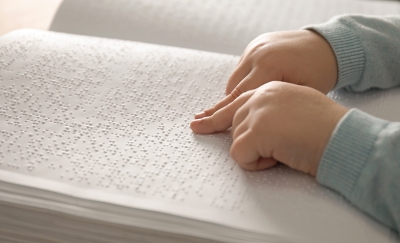
Since 2019, January 4 has been observed as World Braille Day globally. Declared by the United Nations to commemorate the birth anniversary of Louis Braille, the day aims to raise awareness on the importance of Braille as a means of communication in the full realisation of human rights for the blind and partially sighted people.
What is Braille?
Braille is a tactile writing system used by people who are visually challenged. It uses six raised dots in various combinations to represent alphabetic and numerical symbols. Musical, mathematical and scientific symbols are also represented in Braille. Sometimes mistaken as a language, Braille is actually a codified system in which different languages can be written and read. Visually impaired people can read the letters by touching them. Braille helps people with disabilities read and access the same books that are available in visual font. It is a step towards inclusivity.
The story behind Braille
Braille is named after its inventor Louis Braille (in picture). Louis Braille was born in 1809 in Coupvray, near Paris, France. When he was three years old, Braille’s eye was poked accidentally by an awl with which he was trying to make holes in a piece of leather Though he was treated by a doctor, his condition became worse as the wound got infected and slowly spread to his other eye as well. By the time he was five Braille lost vision in both eyes He then enrolled in the Royal Institute for Blind Youth in Paris when he was ten. The school was one of the first in the world to cater to visually impaired students. It was during his time here that he invented the Braille.
In 1821, Charles Barbier, a retired army captain visited the institute to demonstrate his invention of night writing, a system for soldiers to communicate at night without sound or light. His system combined 12 dots to represent sounds Barbier called his system Sonography, but it was also known as night writing. Sonography was introduced in the institute and the students took to it despite its complexity. However, Braille and his classmates found flaws in Barbier’s system. Sonography was based on the 36 sounds of the French alphabet and did not lend itself to spelling or punctuation.
Braille was thus determined to improve upon Barbiers system. Braille worked hard on perfecting an embossed dot system that would be flexible and easier to understand. He used his free time refining the code. And, when he was 15, he shared his system with Dr. Pignier, the institute’s director and his mentor. encouraged the students at the institute to use Braille’s code, and soon enough, they were able to achieve a level of literacy previously unavailable to them.
The role of technology
While Braille was a breakthrough when it was introduced, today, technology has also come to the fore to aid the visually impaired. Earlier, access to reading materials was restricted to Braille books, but today there are EPUB (electronic publication) e-books as well as DAISY (Digital accessible information system) audiobooks and periodicals that offer access to a variety of content. These books can be accessed using a smartphone or computer, and the gadgets are equipped with virtual assistants, narrators and text-to speech recognition.
Digital talking books
There are many apps and gadgets that help the visually impaired. Victor Reader Stream is one such handheld device that plays DAISY digital talking books, EPUB e-books, MP3 and MP4 files, and other media formats that come with Wi-Fi capabilities.
Easy navigation
Seeing A is an app that helps users navigate around places and understand what they are seeing. The app uses rich audio descriptions to keep the user informed. The user can point a camera at something and the app will describe how many people it can see and where they are – centre, top left and so on. The app can also scan a barcode and tell the user what product he or she is holding. It can also read out a handwritten note.
Audio-based technology
Microsoft Soundscape is a research project that explores the use of innovative audio-based technology to enable people to build a richer awareness of their surroundings. The app uses 3D audio cues to enrich ambient awareness and build a mental map of unfamiliar places. It can read out the names of stores and even prompt if there is a signal nearby. The app is currently available only for iOS devices.
How students have helped
Many students have also come up with technologies that can help people with disabilities. In January 2014, Shubham Banerjee, a 13-year-old, designed a Braille printer using a Lego Mindstorms EV3 kit. The cost of this printer is comparatively cheaper than a traditional Braille printer.
In 2017, two students from IIT Kanpur developed a prototype of a Braille slate called ‘Anubhav’. The slate has raised dots and a stencil that slides down over the paper placed on it. The dots are embossed on the paper with a hollow tube stylus, enabling the user to read as he writes instead of having to flip the paper over.
More recently, in November 2020, four students from IT Madras came together to develop a device for the visually impaired. The assistive device fits into the port of a smartphone and helps them to type, learn and read braille content. It also allows them to self-navigate through space and recognise people and objects.
Picture Credit : Google

